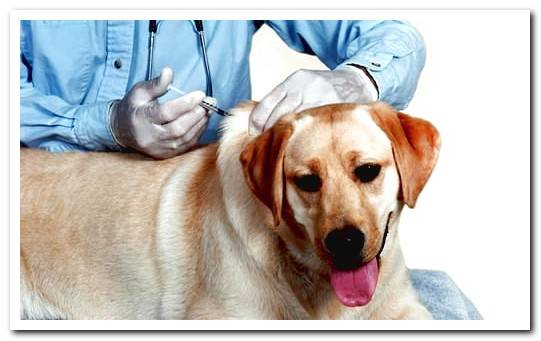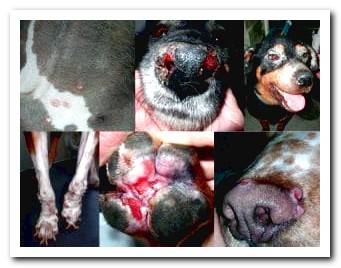
Leishmaniasis is a disease caused by a protozoan that can spread to animals and people. It is transmitted through the bite of a sandfly mosquito, more common in warm climates.
It produces a great diversity of symptoms and is expanding due to climate change. Luckily, there are increasingly better treatments to cope with it. In addition, we can adopt preventive measures, in addition to deworming. Do you want to know more? Let’s go there.
- You may also like: Anti-parasitic and anti-rifle collar.
Index of contents
- 1 What is leishmaniasis?
- 2 Which dogs have leishmaniasis?
- 3 How is leishmaniasis transmitted?
- 4 The life cycle of leishmania
- 5 Leishmaniasis transmission from dog to dog
- 6 Leishmaniasis symptoms
- 7 Dogs with leishmaniasis without symptoms
- 8 Types of leishmaniasis
- 9 How is leishmaniasis diagnosed?
- 10 Leishmaniasis treatment
- 11 Prognosis of leishmaniasis in dogs
- 12 Care for a dog with leishmaniasis
- 13 Antiparasitic against leishmaniasis
- 14 Leishmaniasis prevention
- 15 Leishmaniasis vaccine
- 16 Can people have leishmaniasis?
- 17 What is the current situation of leishmaniasis?
What is leishmaniasis?
Leishmaniasis, also known as leishmaniasis, is a parasitic disease that is caused by protozoa of the Leishmania genus. Distributed all over the world, they are more present in hot climates regions like the Mediterranean, South America, Asia or Africa. There are several clinical manifestations of the disease.
Which dogs have leishmaniasis?
Those specimens that live in warm areas will be more likely to contract the disease. Likewise, large dogs are more contagious, since they are the ones that most often live outdoors, being more exposed to the mosquito.
How is leishmaniasis transmitted?
The disease is contracted through the bite of a mosquito called a sandfly. The females of this insect feed on blood to lay eggs. Its activity is focused in the sunrise and sunset hours hot days.
The rest of the day will remain hidden, introducing itself into cavities. It is found in rural and wooded environments and survives the cold months by remaining in the larval stage. It is a small mosquito that, therefore, can go unnoticed.
The life cycle of leishmania
The cycle begins when a mosquito bites a dog infected with leishmanias, since these are located in the blood. When they reach their stomach they evolve to a phase called promastigote, which is elongated and has a scourge. They are those that reproduce and infect another animal, when the mosquito bites again.
In it, the parasites will invade cells called macrophages, which are a type of white blood cell. At this time they acquire an ovoid shape called amastigote and spreads throughout the body. If a mosquito bites this infected dog, the cycle continues.
Thus, the dog is the reservoir of the disease, while the mosquito acts as a vector. Both are essential for leishmania to complete its cycle. A single mosquito is capable of infecting several dogs during its life.
Leishmaniasis transmission from dog to dog
In principle, and this is the case in practically all cases, the spread of leishmaniasis in dogs is caused by the bite of the mosquito that has previously bitten a dog with leishmanias. But it seems that transmission from a bitch to her puppies is possible, and also contagion through sexual contact and / or nibbling.

Leishmaniasis symptoms
There are numerous symptoms with which this disease can manifest, but there will also be infected dogs that are asymptomatic. The problem with these cases is that they can be a source of contagion without us knowing it.
After an incubation period, which will vary from one specimen to another, in dogs we can find ourselves clinical signs as varied as the following, depending on the type of leishmaniasis and the severity of the infection:
- Sometimes the mosquito bite is observable.
- Hair loss, especially around the eyes, ears and nose.
- Thickened skin on the nose and fingers.
- Wounds, which also will not heal, especially in the contact areas and surrounding the eyes.
- Fine and dull hair.
- Exaggerated nail growth.
- Weight loss, although the appetite remains normal.
- Swollen glands.
- Conjunctivitis.
- Lethargy.
- Limp.
- Joint pains.
- Nosebleeds.
- Renal insufficiency.
- Digestive problems.
- Liver disorders.
Dogs with leishmaniasis without symptoms
If we live in an area where leishmaniasis is a common disease, even if our dog does not present symptoms, it is recommended that we regularly do an analysis to find out if it carries the parasite or not.
According to the result, we will establish the appropriate measures. In addition, if we adopt a dog from a risk area and we do not know its status regarding this disease, we must follow this same protocol.
Types of leishmaniasis
- Visceral leishmaniasis: It is the one that will affect the internal organs.
- Cutaneous leishmaniasis: As its name suggests, it produces dermatological symptoms.
How is leishmaniasis diagnosed?
To find out if our dog has leishmania or not, in the veterinary center it is possible to carry out a quick test from a blood sample, although false negatives may occur. For this reason it is also important to pay attention to the clinical picture.
In addition, the test will not detect the disease if the dog is in the initial stages of the process, nor does it allow information on the amount of protozoa or the course of the infection. For a safer and more specific diagnosis, laboratory tests can b
e used, and bone marrow or lymph node samples can also be used.

Leishmaniasis treatment
The goal of treatment is to control the symptoms, because the parasite is not going to be eliminated, although it is intended to make it difficult to reproduce. All affected dogs should be treated as soon as possible, not only for their own well-being, but to decrease the risk of transmission.
It is usual for this treatment must be administered to the dog throughout its life and it is necessary to establish periodic veterinary controls. Keep in mind that dogs can improve, but also suffer relapses.
Various drugs are used in combination and can be administered orally or by injection. The veterinaryn, depending on each case, will decide which are the best and will provide us with the necessary follow-up.
Prognosis of leishmaniasis in dogs
Leishmaniasis is a life-threatening disease. If the dog does not receive treatment, it is likely to die. Survival improves the sooner you start administering this.
The prognosis also depends on how the dog’s immune system reacts to the prescribed treatment. Although there is no definitive cure for this disease, it is possible to get the dog to live for years with good quality.
Care for a dog with leishmaniasis
In addition to administering the treatment as prescribed by the vet, at home we can adopt some measures that help improve the condition of the dog. They are basic care for any dog, essential for a sick animal:
- Provide warm and sheltered accommodation.
- Avoid as much as possible any factor that may trigger you stress.
- Assure him good food, with quality proteins, since it is important to ensure that he maintains his appetite and nourishes himself, and clean and fresh water freely available.
- Supplements may be required, according to veterinary criteria.
Antiparasitic against leishmaniasis
The best way to avoid this serious disease is to prevent the mosquito from biting the dog. For this, especially, necklaces or pipettes that repel the insect are used. The collars protect about 4-8 months And, since we put it on, it takes about a week to start taking effect.
The pipettes, on the other hand, offer protection for a shorter time, about 3-4 weeks, but begin to act sooner, around 24-48 hours after their application. The vet will advise us on the best option according to the characteristics of our dog.
Leishmaniasis prevention
- In addition to using dewormers against sandfly, we can use insecticides or ultraviolet light traps in the home and in the accommodations.
- In seasons when the mosquito is active, the ideal is to prevent the dog from staying outside, at least during the hours of greatest risk.
- Walks at dawn or dusk are also not recommended.
- We must not accumulate organic matter in the garden or in the garden, as the mosquito larvae feed on it.
- Sterilization would avoid the risk of transmission through sexual or maternal contact.
- We will not allow the dog to roam uncontrollably. Bites could be involved in the transmission of leishmania.
- At home we can also reduce the presence of mosquitoes using mosquito nets on doors and windows.
Leishmaniasis vaccine
Finally, for some years now, a recombinant vaccine against this disease has been available. It is administered in a single dose from six months of age and must be repeated annually.
Before putting it, it is necessary to know the state of the dog with respect to the disease, since it cannot be infected. The vaccine does not prevent the mosquito bite, so it must be combined with dewormers.
Can people have leishmaniasis?
Yes, leishmaniasis is a disease that humans can also suffer, especially those who live in warm areas, for example, in South America or Asia and / or have an immature or weakened immune system.
It is, therefore, a zoonosis, that is, a pathology that animals can transmit to humans. The dog will not directly infect a person, but by acting as a reservoir, it can infect mosquitoes that later bite humans.

What is the current situation of leishmaniasis?
This disease is currently spreading, that is, more and more cases are diagnosed and in larger areas. It is foreseeable that its progress will continue as a consequence of climate change that is increasing temperatures worldwide.
